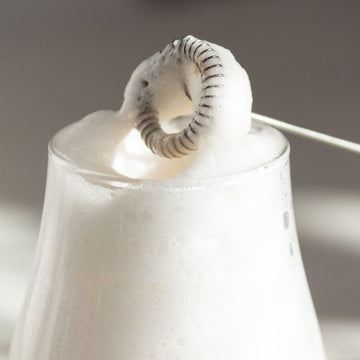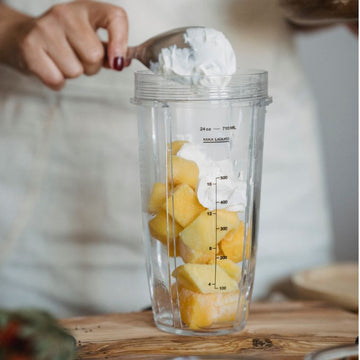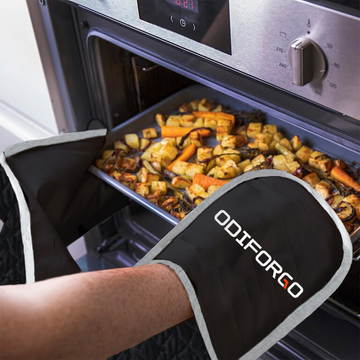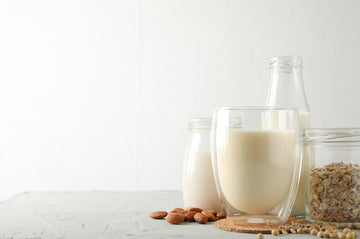Milk alternatives have come a long way from being niche options for people with dietary restrictions. Today, drinks like oat milk and almond milk are common in homes, cafes, and grocery aisles. And not just because they’re dairy-free.
If you're trying to steam the perfect cappuccino or are looking for something gentler on your stomach, the type of plant milk you choose can alter the flavor, texture, and performance of your drink.
If you’re debating between oat milk and almond milk, this article will help you understand the differences, especially when it comes to taste, nutrition, and how well they hold up to frothing. Let’s take a look at what each one brings to the table.
What is oat milk?
Oat milk is made by blending oats with water and straining out the solids. Its texture is naturally creamy, which is why many people use it as a substitute in lattes, cereals, and smoothies. Most brands also add enzymes to break down the oats into natural sugars, giving oat milk a mild, slightly sweet flavor even without added sugar.
In terms of nutrition, oat milk usually contains more carbohydrates than other non-dairy milks, but it’s often fortified with calcium, B vitamins, and vitamin D. Its thicker consistency makes it an easy stand-in for whole milk. Especially when steaming. It generally froths well, even without barista-specific formulations, which is one of the main reasons cafes lean toward using it.
What is almond milk?
Almond milk is made by soaking almonds, blending them with water, and straining out the pulp. The result is a much lighter consistency than oat milk, with a more neutral or nutty flavor depending on the brand. Unsweetened versions tend to be low in calories, carbs, and sugar, which is why almond milk remains a popular choice for people managing their weight or blood sugar.
That said, almond milk isn’t known for its frothing abilities. Most store-bought versions are thin, and unless you use a barista blend with stabilizers and fats, they tend to separate or create large bubbles when steamed. That doesn’t mean you can’t use almond milk for lattes. It just takes more patience and the right kind of milk.

Oat milk vs. almond milk
Both oat milk and almond milk are widely used plant-based alternatives to dairy, but they offer very different experiences in terms of taste, nutrition, and environmental impact.
Oat milk has a naturally creamy consistency and a subtle sweetness, which makes it feel more similar to cow’s milk. It blends smoothly into both hot and cold drinks, works well in baking, and adds a pleasant body to sauces or cereals. Since oats are naturally higher in carbohydrates, oat milk tends to contain more calories than almond milk, especially in unsweetened versions. It also has more fiber, and many brands enrich it with vitamins and minerals like calcium, vitamin D, and B12.
Almond milk is thinner, with a mild nutty flavor that doesn’t overpower recipes. It’s a common choice for people following low-carb or low-calorie diets. Unsweetened almond milk is especially light, often containing fewer than 40 calories per cup. However, it usually has less fiber and protein than oat milk unless fortified.
From a sustainability perspective, oat milk is generally considered more eco-friendly. Oats require significantly less water to grow than almonds, making oat milk a more responsible choice for those concerned about agricultural water usage.
In daily use, oat milk is favored for creaminess and taste, while almond milk is preferred for its low calorie content and neutral flavor. Choosing between the two often comes down to what you're using it for and what dietary needs you're trying to meet.
Frothing oat milk vs. almond milk

When it comes to frothing, oat milk consistently outperforms almond milk. The main reason lies in their composition. Particularly the balance of protein, fat, and carbohydrates. Frothing relies on proteins and fats to create a stable microfoam, and oat milk tends to contain more of both than almond milk. Even without additives, its natural starches help stabilize the foam, resulting in a creamier, smoother texture that closely mimics dairy milk.
Almond milk, on the other hand, is thinner and contains less protein, which makes it more difficult to froth evenly. Without the help of added emulsifiers or stabilizers (often found in barista-style almond milk), almond milk tends to separate under heat and produces larger, unstable bubbles. This makes it a bit trickier to work with if you're aiming for that velvety foam needed for latte art.
In a home setup using a standard steam wand or handheld frother, oat milk is far more forgiving. You don’t need perfect timing or temperature control to get a decent result. With almond milk, frothing becomes more of a hit-or-miss experience. Especially if you're using a generic grocery brand. If you're set on almond milk for dietary reasons, it's worth seeking out one specifically labeled for baristas or formulated for steaming.
In terms of taste, oat milk’s natural sweetness and density give it a dairy-like mouthfeel, which complements espresso-based drinks well. Almond milk offers a lighter, nuttier profile that can taste sharper or slightly bitter when heated. Some prefer it for cold drinks, where its flavor holds up without being masked by heat.
So if your goal is to make café-style drinks at home with consistent froth and texture, oat milk is the easier and more reliable choice. Almond milk can work, but you’ll likely need to be more selective about the brand and invest extra effort into technique.
What about soy, coconut, and other milks?
While oat and almond milk dominate most grocery shelves, they’re not the only dairy alternatives worth considering. Depending on what you’re after, protein, creaminess, or flavor neutrality, other plant-based milks might suit your needs better.
-
Soy milk is often considered the most nutritionally comparable to cow’s milk. It has a solid amount of protein per serving (around 7g), a mild beany flavor, and a slightly thicker consistency than almond milk. It's a solid all-around choice, especially for those looking for a higher-protein alternative. In frothing, it holds up fairly well, though sometimes forms larger bubbles if not handled correctly.
-
Coconut milk (the kind made for drinking, not the canned version) is light and slightly tropical in flavor. It’s lower in protein but adds a rich mouthfeel to coffee and smoothies. However, it can separate under heat or pressure, making it trickier to froth or heat up unless it’s a barista-style version.
-
Rice milk is the most hypoallergenic option, making it ideal for people with nut, soy, or gluten intolerances. It’s very thin, sweet, and watery, with little fat or protein. This makes it a poor choice for frothing or thickening but usable in cereal or cooking.
-
Pea protein milk (like Ripple) is a newer player with surprisingly good nutritional stats. High protein, creamy texture, and a very mild flavor. It behaves well in both frothing and cooking and is growing in popularity among vegans and athletes.
-
If you still use dairy milk, it's worth noting that whole milk froths the best due to its fat content, but oat milk has become a close plant-based contender for baristas and home coffee drinkers alike.
In short, oat milk strikes the best balance for texture and taste, almond milk wins for low calories, and others like soy or pea milk are better for protein or dietary needs. The “best” milk depends less on trends and more on what you’re actually using it for.
Choosing what to pour in your cup
Oat milk and almond milk each bring something different to the table. Whether it's the creaminess of oats or the light, nutty profile of almonds. If frothing is your priority, oat milk is likely your best bet thanks to its natural body and stability under heat. But if you're watching calories or prefer a more neutral flavor, almond milk may suit your needs better.
Ultimately, the best choice depends on your habits, health goals, and how you like your coffee, smoothies, or cooking. Don't be afraid to test a few options and see which one fits into your routine.














